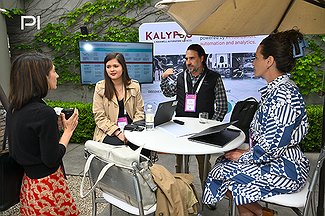Market Key hosted PI Apparel West Coast with an exhibitor section, educational seminars and roundtable sessions to support collaboration between fashion professionals and technology innovators. | Photo courtesy of PI Apparel STEVE SHERMAN
TECHNOLOGY
AI and Data Highlighted as the Future of Fashion During PI Apparel in L.A.
PI Apparel West Coast visited Los Angeles recently when parent company Market Key hosted the event at the Luxe Sunset Boulevard Hotel. After nearly a decade of hosting a PI Apparel West Coast edition, the conference brought together fashion professionals from different areas of the industry including design, manufacturing, retail and education to forge introductions with the savvy technology innovators who will lead the business toward solutions that will support customer conversion, supply-chain management, designer communication and transparent sourcing.
The event addressed fashion’s largest current pain points that can be solved through technology solutions. It was the source for exploring technological innovations with a heavy focus on artificial intelligence and leveraging data to streamline business practices across the industry.
Moving beyond the AI fear
The allure of creating ease for workers through technology is high, but recent advancements, including AI, have left some in the fashion industry—and nearly every other business—afraid of the power these tools could eventually wield and the jobs it could replace.
“The work is not going away, it’s just changing. What we try to do with AI is we want designers, merchandisers, developers and testers to do the things they want to do and not enter data into spreadsheets all day,” explained Matt Nakari, sale GEO lead for product lifecycle management provider Centric Software.
Many professionals in the technology industry who have developed these solutions understand that new innovations can seem scary but have simply been developed to reduce the burden of mundane tasks that prevent workers from completing the tasks they were hired to perform.
“A goal for every brand is to shorten your timeline, and when you implement PLM and digital product creation your initial out-of-the-box is that you might not shorten that end-to-end time but you’re going to streamline and make it more efficient in the middle so you can do things better,” Nakari said.
At the DeSL booth, Addison Cole, senior business consultant for the PLM provider, noted that the more intimate setting of the May 21–22 event allowed representatives from brands of every size to comfortably search for solutions that would best fit their operations.
“Some customers we’ve seen don’t have PLM at all so we’re getting a lot more SMB customers, which is good,” Cole said. “AI and how things are going to be used [are buzzworthy]. There have been a lot of talks about AI in the sessions. Just getting engagement with the customers to see how they would be using it is important because it’s the future.”
When reflecting on the challenges fashion is currently facing, Ruoxi Gao, senior solutions manager for the brand innovation lab at Amazon, had advice for technology companies as they tackle these different issues that are limiting progress in the industry.
“There are a lot of problems to be solved, and a lot of tech companies are trying to solve them,” Gao said. “It’s important to really know how brands work internally, how designers work and how they actually think in order to help themselves to connect the problem with the solution.”
Collaboration over competition
Fashion’s state as an industry in which businesses have been secretive and, typically, unwilling to share best practices due to fear of revealing too much, resulting in loss of intellectual property or proprietary information, stifles progress. In recent years, however, this hurdle has been slowly lowered as brands, designers and manufacturers discover business is better and the industry stronger through sharing ideas surrounding greater efficiency, sustainability and resources.
“I’ve been shocked at how much collaboration over competition I am seeing. People from different walks of life and organizations are talking, and ideas can come from everywhere. The problems are so big—to solve them you can’t do enough collaboration,” said Hamilton Perkins, founder of a Norfolk, Va.–based eponymous brand of sustainable bags and accessories. “You’re learning from them; they’re learning from you. The biggest things are communication and collaboration.”
Blockchain is one area of technology that can help move the industry forward in the spirit of collaboration and information sharing while also protecting brands’ intellectual property. As more brands contribute data to blockchain technology, traceability along the supply chain increases, which creates a more reliable, trustworthy industry. With sustainability regulations passing in the EU and United States, a transparent supply chain is crucial to aligning with new legislation. The technology also protects brands and their customers by facilitating authentication of products.
“Today, with the regulatory landscape, brands need to step up their game in terms of tracing their products and the origins of their products, so our talk focused on the basics of those logistics and getting people to start thinking about it,” said Chelsea Snyder, senior technical consultant at Kalypso LP, the digital-services provider for Rockwell Automation. “It’s not a sexy, exciting subject. Sometimes the word ‘sustainability’ makes it a bit more alluring, and there are solutions like PLM solutions that have the ability to collect data and traceability and blockchain as well.”























